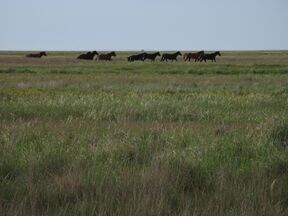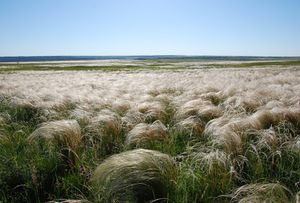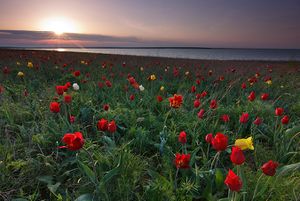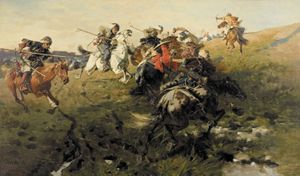سهوب پنطس-القزوين
| السهوب الپنطية-القزوينية | |
|---|---|
 The steppe in Azov-Syvash National Nature Park, Ukraine, with reintroduced horses. | |
 | |
| علم البيئة | |
| النطاق | Palearctic |
| حيوم | Temperate grasslands, savannas, and shrublands |
| الجغرافيا | |
| المساحة | 994،000 km2 (384،000 sq mi) |


سهوب پنطس-القزوين Pontic–Caspian steppe، أو السهوب الپنطية Pontic steppe هي أرض سهوب شاسعة تمتد من السواحل الشمالية للبحر الأسود (المسمى Euxeinos Pontos [Εὔξεινος Πόντος] في القِدم) وتمتد شرقاً حتى بحر قزوين، من مولدوڤا وشرق أوكرانيا عبر منطقة شمال القوقاز الاتحادية، المنطقة الاتحادية الجنوبية و منطقة الڤولگا الاتحادية في روسيا إلى غرب قزخستان، مشكـِّلة جزءاً من السهوب الأوراسية الأكبر، وملاصقة للسهوب القزخية إلى الشرق. وهي جزء من Palearctic temperate grasslands, savannas, and shrublands ecoregion of the temperate grasslands, savannas, and shrublands biome.
The area corresponds to Cimmeria, Scythia, and Sarmatia of classical antiquity. Across several millennia the steppe was used by numerous tribes of nomadic horsemen, many of which went on to conquer lands in the settled regions of Europe and in western and southern Asia.
The term Ponto-Caspian region is used in biogeography for plants and animals of these steppes, and animals from the Black, Caspian, and Azov seas. Genetic research has identified this region as the most probable place where horses were first domesticated.[1]
According to a theory, called Kurgan hypothesis in Indo-European studies, the Pontic–Caspian steppe was the homeland of the speakers of the Proto-Indo-European language, and these same speakers were the original domesticators of the horse.[2][3][4][5]
الجغرافيا والبيئة
The Pontic steppe covers an area of 994،000 متر كيلومربع (384،000 sq mi) of Europe, extending from Dobrudja in the northeastern corner of Bulgaria and southeastern Romania, across southern Moldova, Ukraine, through Russia to northwestern Kazakhstan to the Ural Mountains. The Pontic steppe is bounded by the East European forest-steppe to the north, a transitional zone of mixed grasslands and temperate broadleaf and mixed forests.
To the south, the Pontic steppe extends to the Black Sea, except the Crimean and western Caucasus mountains' border with the sea, where the Crimean Submediterranean forest complex defines the southern edge of the steppes. The steppe extends to the western shore of the Caspian Sea in the Dagestan region of Russia, but the drier Caspian lowland desert lies between the Pontic steppe and the northwestern and northern shores of the Caspian. The Kazakh Steppe bounds the Pontic steppe on the southeast.
The Ponto-Caspian seas are the remains of the Turgai Sea, an extension of the Paratethys which extended south and east of the Urals and covering much of today's West Siberian Plain in the Mesozoic and Cenozoic.
ثقافات قبل التاريخ
- Linear Pottery culture 5500–4500 BC
- Cucuteni-Trypillian culture 5300–2600 BC
- Khvalynsk culture 5000-3500 BC
- Sredny Stog culture 4500–3500 BC
- Yamna/Kurgan culture 3500–2300 BC
- Catacomb culture 3000–2200 BC
- Srubna culture 1600–1200 BC
- Novocherkassk culture 900–650 BC
شعوب وأمم تاريخية
- Cimmerians 12th–7th centuries BC
- Dacians 11th century BC – 3rd century AD
- Scythians 8th–4th centuries BC
- Sarmatians 5th century BC – 5th century AD
- Ostrogoths 3rd–6th centuries
- Huns and Avars 4th–8th centuries
- Bulgars (Onogurs) 4th–7th century[6]
- Alans 5th–11th centuries
- Eurasian Avars 6th–8th centuries
- Göktürks 6th–8th centuries
- Sabirs 6th–8th centuries
- Khazars 6th–11th centuries
- Pechenegs 8th–11th centuries
- Kipchaks and Cumans 11th–13th centuries
- Mongol Golden Horde 13th–15th centuries
- Cossacks, Kalmyks, Crimean Khanate, Volga Tatars, Nogais and other Turkic states and tribes 15th–18th centuries
- Pontic Greeks and Caucasus Greeks 15th–19th centuries
- Russian Empire 18th–20th centuries
- Soviet Union 20th century
- Moldova, Kazakhstan, Russian Federation, Ukraine 20th–21st centuries
انظر أيضاً
المراجع
- ^ "Mystery Of Horse Domestication Solved?". sciencedaily.com. Retrieved 3 April 2018.
- ^ David W. Anthony. The Horse, the Wheel, and Language: How Bronze-Age Riders from the Eurasian Steppes Shaped the Modern World. Princeton University Press. ISBN 9781400831104.
- ^ Haak, Wolfgang; Lazaridis, Iosif; Patterson, Nick; Rohland, Nadin; Mallick, Swapan; Llamas, Bastien; Brandt, Guido; Nordenfelt, Susanne; Harney, Eadaoin; Stewardson, Kristin; Fu, Qiaomei; Mittnik, Alissa; Bánffy, Eszter; Economou, Christos; Francken, Michael; Friederich, Susanne; Pena, Rafael Garrido; Hallgren, Fredrik; Khartanovich, Valery; Khokhlov, Aleksandr; Kunst, Michael; Kuznetsov, Pavel; Meller, Harald; Mochalov, Oleg; Moiseyev, Vayacheslav; Nicklisch, Nicole; Pichler, Sandra L.; Risch, Roberto; Guerra, Manuel A. Rojo; Roth, Christina; Szécsényi-Nagy, Anna; Wahl, Joachim; Meyer, Matthias; Krause, Johannes; Brown, Dorcas; Anthony, David; Cooper, Alan; Alt, Kurt Werner; Reich, David (10 February 2015). "Massive migration from the steppe is a source for Indo-European languages in Europe". bioRxiv: 013433. arXiv:1502.02783. doi:10.1101/013433. Retrieved 3 April 2018 – via biorxiv.org.
- ^ Population genomics of Bronze Age Eurasia, Allentoft et al, 2015
- ^ Mathieson, Iain; Lazaridis, Iosif; Rohland, Nadin; Mallick, Swapan; Llamas, Bastien; Pickrell, Joseph; Meller, Harald; Guerra, Manuel A. Rojo; Krause, Johannes; Anthony, David; Brown, Dorcas; Fox, Carles Lalueza; Cooper, Alan; Alt, Kurt W.; Haak, Wolfgang; Patterson, Nick; Reich, David (14 March 2015). "Eight thousand years of natural selection in Europe". bioRxiv: 016477. doi:10.1101/016477. Retrieved 3 April 2018 – via biorxiv.org.
- ^ "Archived copy". Archived from the original on 2013-12-24. Retrieved 2013-12-24.
{{cite web}}: Unknown parameter|deadurl=ignored (|url-status=suggested) (help)CS1 maint: archived copy as title (link)
وصلات خارجية
- CS1 errors: unsupported parameter
- Russia articles missing geocoordinate data
- All articles needing coordinates
- Eurasian Steppe
- Temperate grasslands, savannas, and shrublands
- Grasslands of Asia
- Grasslands of Europe
- المناطق البيئية في آسيا
- Ecoregions of Europe
- Ecoregions of Bulgaria
- Ecoregions of Kazakhstan
- Ecoregions of Russia
- Grasslands of Moldova
- Grasslands of Romania
- Grasslands of Russia
- Grasslands of Ukraine
- آسيا الوسطى
- شمال القوقاز
- نبيت آسيا الوسطى
- نبيت شرق أوروپا
- جغرافيا جنوب روسيا
- التاريخ الطبيعي لآسيا الوسطى
- جماعات بدوية في أوراسيا
- Iranian nomads
- سكوذيا
- Palearctic ecoregions

